Page
Opinion: Political truth behind Green smokescreen
The opinion piece was originally published in the Daily Telegraph.
In the words of Public Enemy: “Don’t believe the hype!’’ There has been a lot of rhetoric from the Greens and their supporters as to their performance at the election on the weekend however it is, on the whole, unfounded.
The Greens may have won an extra lower house seat or two on Saturday but they completely failed to increase their statewide support.
For example, in every single mining seat in the Hunter and Illawarra, the Greens vote went backwards at this election, just as it did for the majority of these seats at the last election four years ago.
At the 2011 election the Greens received around 10.3 per cent of all lower house votes cast. Last Saturday their share of the lower house vote was almost exactly the same.
More to the point, support for the Greens actually went backwards where it counts the most for minor parties — in the upper house.
This is where the Greens failure is most acute, because it’s in the upper house that the Greens, if elected in sufficient numbers, can actually block or amend legislation.
Four years ago at the 2011 election the Greens received 11.1 per cent of votes cast for the upper house. Based on the latest counting, last Saturday the Greens received just over 10 per cent of upper house votes, meaning they actually lost one in 10 of these crucial votes.
And, in doing so, they look like failing to win a third seat in the upper house, which would have delivered them a parliamentary vote far more meaningful for them than a few token seats in the lower house.
Across the state, with the exception of a few hot spots, the Greens have flopped.
In south-western Sydney, the Greens also went backwards, even with their hysterical and prolonged anti-CSG campaigning there.
And closer examination of the results on the North Coast where the Greens look likely to pick up the seat of Ballina, reveal their performance there was far from convincing.
The Greens look like they have won Ballina, but with only around 30 per cent of the primary vote, and only because Labor directed preferences.
In other words, seven out of every 10 voters in the Ballina electorate voted for someone other than the Greens.
Newtown is the other electorate where the Greens have won a seat. The story there is more positive for the Greens, with around 45 per cent of the primary vote and a convincing win. But let’s not forget this is inner city, latte-loving, left-leaning Newtown we’re talking about. Greens heartland, where they control the local Marrickville Council.
So the strong showing by the Greens in Newtown should really be no great surprise to anyone, except perhaps the Labor Party, who were comprehensively beaten in their attempt to compete for Newtown’s greenie, left-leaning voters.
More generally, Labor’s decision to do a preference deal with the Greens across the state continues to provide a political boost to the party that represents the greatest long-term threat to the ALP’s future.
Labor’s political identity crisis is becoming starker with every election. Sooner or later the crunch is going to come.
Does Labor want to be a legitimate mainstream political party with responsible economic credentials, or just a pale imitation of the Greens?

